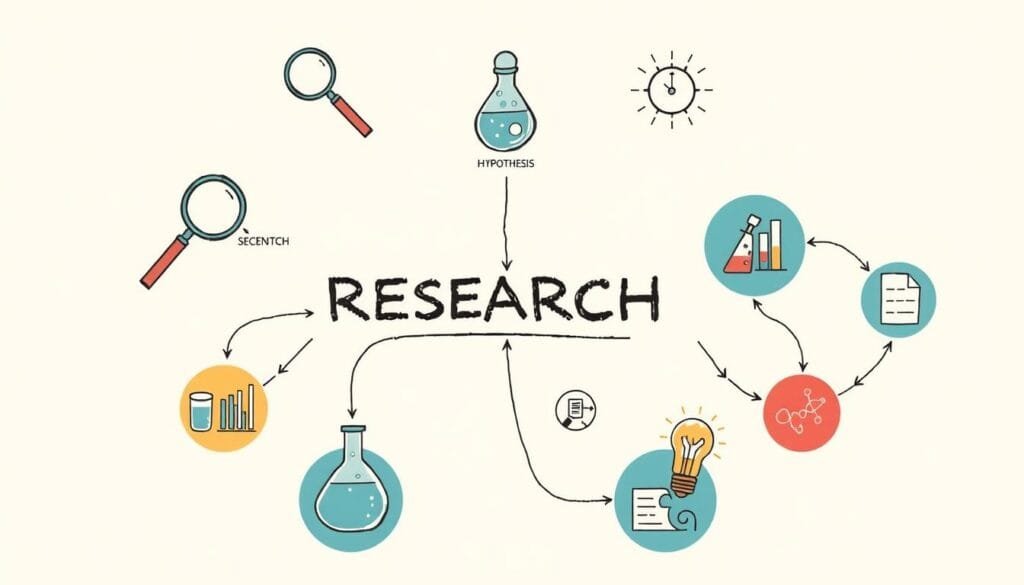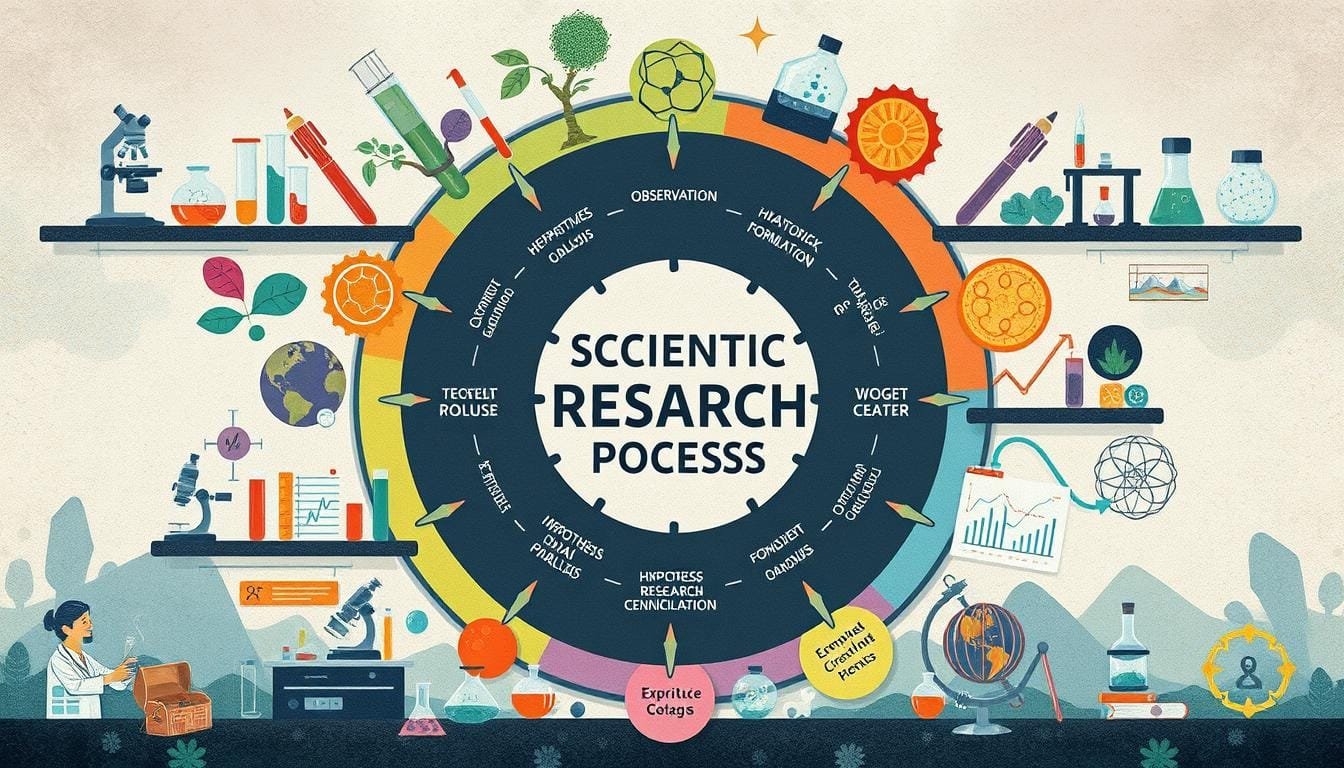Exploring knowledge with the scientific inquiry process is key in fields like science, technology, and business analytics. This journey follows a solid research methodology to build on proven facts. It helps pros and scholars make discoveries that deepen our world understanding12.
Key Takeaways
- Knowing the steps in the scientific research process adds to reliable empirical analysis.
- Research questions come from noticing patterns and trends1.
- Doing background research adds insight and helps create a solid hypothesis12.
- Empirical analysis in experiments follows ethics and rigorous review1.
- Research findings must hold up under peer review and spark more studies2.
- Sharing results with the science community is essential2.
Understanding the Scientific Method
The scientific method is a key way to study and understand the world. It helps researchers follow a strict path of discovery. The idea of being able to prove something wrong, known as falsifiability, is crucial. It makes sure that scientific statements can be tested and even proved false through experiments. This approach not only makes the data more reliable but also ensures that research findings are useful in different areas.
Definition and Importance
The scientific method is known for its ordered steps. These include observing, making a hypothesis, predicting, experimenting, and analyzing outcomes345. It is based on empiricism. This concept suggests that knowledge comes from experience. Thinkers like John Locke heavily promoted this idea4. The method is vital in science, tech development, and improving business operations3.
Overview of the Process
The scientific method includes several steps, from observing to improving hypotheses. It starts with careful observation. Then, it involves asking a question, coming up with a hypothesis, and testing it through experiments45. Famous figures like Francis Bacon and René Descartes played a big role in defining this method in the 16th and 17th centuries. Thanks to their work, it’s a foundation in physics, chemistry, and psychology today45. This process is not just about getting results. It emphasizes that hypotheses need to be testable and could be proven wrong3.
| Component | Description | Application |
|---|---|---|
| Observation | Initial stage where an anomaly or a point of interest is identified. | Basic and applied science, technology troubleshooting3 |
| Hypothesis | A testable prediction derived from the observed phenomena. | Business analytics, clinical trials3 |
| Experimentation | Controlled testing to validate or refute the hypothesis. | Chemical, physical, and social sciences4 |
| Analysis | Assessing experiment results to form conclusions. | Empirical research, data analytics5 |
The scientific method remains crucial today. It’s not just about gaining knowledge. It’s also about solving real-world problems in many areas345.
What are the steps in scientific research
Scientific research begins with a strong research question. This question comes from first noticing something curious. Forming this question correctly is crucial as it steers all the next steps to prove or disprove a hypothesis.
The process then moves on to gather relevant background information. This helps in forming a testable hypothesis6. It’s important that this hypothesis is simple and clear, setting the stage for testing6.
After the hypothesis is in place, experiments are designed and carried out. These tests check if the hypothesis is true by changing certain factors and recording what happens6.

Data is then carefully recorded and analyzed6. This step checks if the results are reliable and support or deny the hypothesis. It uses statistics to explain what was observed during testing6.
The final step is sharing the results. Scientists write articles and give talks about their work. This way, they spread their discoveries to others6.
| Type of Research | Data Collection Techniques | Time Perspective |
|---|---|---|
| Observational | Descriptive or Analytical | Prospective, Retrospective, or Cross-sectional |
| Experimental | Procedure Analysis | Controlled Environment |
Following ethical rules in research shows values like trust and accountability7. It ensures research is dependable and transparent7, maintaining its reputation and public trust.
Formulating a Research Question

Starting a study begins by asking a critical question. This step shapes the study’s path and makes sure it adds new insight. It’s about diving deeper into the subject.
Identifying a Topic of Interest
Choosing a topic means looking at the world or seeking answers that make you curious. The drive behind the study helps pick a topic that’s interesting and doable. A great question often comes from personal interest or where knowledge is lacking, adding new and useful ideas8.
Gathering Preliminary Information
Before settling on a question, researchers gather a lot of early info. They review what’s already known to make sure the question is fresh and important8. This stage helps sharpen the question by looking at different aspects like ethics and how doable the study is8. Knowing the current state of knowledge, whether about society, medicine, or policy, is key8.
Defining the Research Question
The journey’s high point is defining a specific, clear question. A good question uses terms from models like “FINERMAPS”, standing for feasibility, interest, and more8
. Finding the right mix of broad and in-depth topics is crucial. Instead of a general theme, zooming in on specifics provides clear direction9.
Wrapping up, a well-planned question is vital for a study’s success. From choosing a topic to creating hypotheses, careful planning ensures a positive result89.
Conducting Background Research
Background research is key in science. It builds a strong base by understanding what we already know. This lets us see new paths to explore10. Through a detailed review of literature, researchers deepen their knowledge. They can better aim their study this way. The goal is to bring together current data to uncover unanswered questions or spotlight areas that need more focus10.
Information gathering at this point means looking at various scholarly articles, expert views, and key studies that relate to the research question. Crafting this background is crucial. It must draw in readers while being clear and brief to avoid confusion10. This section should briefly cover important literature and link it directly to the research problem. This justifies why the study is needed11.

When writing the background section, researchers must dodge certain mistakes. Skipping important studies can hurt the paper’s credibility10. Not citing sources correctly can also lead to plagiarism claims10. A well-written background keeps the paper’s integrity intact. It also makes the reader more interested and engaged10.
The background research is not just a literature review. It’s a foundation that gathers crucial information. It helps researchers be ready and informed. The aim is to make future research smoother. It also ensures the study adds value to the existing knowledge11.
Developing a Hypothesis
In the world of science, making a strong hypothesis is key. It not only moves research along but also helps in setting testable forecasts. These are important for good scientific thinking.
A hypothesis is really an educated guess aimed to explain something specific. It’s vital because it guides the research steps like experiments and analyzing data.
Crafting a Testable Statement
Making a hypothesis testable means changing broad ideas into exact, measurable guesses. The quality of a hypothesis affects the research’s path and credibility12. The “PICOT” model turns a broad hypothesis into a specific, organized one. It covers population, interest, comparison, outcome, and time, making the research focused and actionable12.
For example, a well-made hypothesis might look into how nitrogen affects plant size. It could say that dandelions grow bigger leaves in nitrogen-rich soil. This is because nitrogen helps plants grow more leaves12.
Importance of a Clear Hypothesis
Being clear and exact in a hypothesis is crucial for trustworthy science. A clear hypothesis shows what outcomes to expect and under what conditions. This is super important in areas like medicine and environmental science. Experiments must follow strict rules to get accurate results12.
A precise hypothesis makes science more effective and efficient12. It creates a clear plan for researchers to follow. This opens the door to important discoveries in science12.
Experimentation and Data Collection
In the world of science, trying new things and gathering data are key steps. Using empirical methods, these stages are done carefully. This approach stresses how vital it is to control conditions and follow plans closely for reliable results.
The first step is to set everything up correctly. For example, changing the water’s temperature can show how fast sugar cubes dissolve. When the water was heated to ninety-five degrees Fahrenheit from seventy-two degrees Fahrenheit, the sugar dissolved differently13. This change in temperature is the independent variable in this experiment13.
Paying close attention to data analysis is crucial as scientists track how these changes affect what happens. In the sugar cube test, they noted how long it took for the sugar to completely disappear. At the higher temperature, the cube dissolved in about twenty-four minutes13.
Exploring further, the use of scientific methods, like empiricism and being objective, shapes how experiments are set upas outlined in scientific methodologies. Such structured methods ensure the results are valid and repeatable, which is crucial for the growth of science14.
| Variable Type | Description | Example from Experiment |
|---|---|---|
| Independent Variable | Condition or factor adjusted by the researchers | Water temperature increased to 95°F |
| Dependent Variable | Observed effects due to changes in the independent variable | Dissolution time of sugar cube |
| Control Variable | Factors kept constant to ensure reliable results | Use of identical sugar cubes and cups |
Clearly, thinking critically and the ability to repeat an experiment are important. They help confirm results and show how temperature changes affect how quickly something dissolves14. True and consistent data collection, along with thorough analysis, is key in proving scientific concepts. This makes scientific studies more reliable and detailed.
Conclusion
The journey of scientific exploration ends with how we interpret and present our findings. A whopping 92% of research papers highlight the need for a clear Conclusion section. This shows the study’s results and summarizes its main message15. It’s crucial, with 95% of these conclusions aiming to show how the study could affect future research. They move beyond just repeating what was said in the Introduction, a method used by 78% of influential studies15.
A strong 83% of effective conclusions pull together the main points for readers. This helps them deeply understand what the science contributes15. Conclusions are more powerful when they end on a strong note. In fact, 72% of them do just that, leaving readers with something to remember15. Also, 45% of research papers make recommendations for future work. And 60% raise new questions to explore, helping to guide more discoveries and innovations15.
Conclusive statements do more than wrap up academic discussions. They make 88% of studies clear enough to impact both experts and the public15. By focusing on sharing results, we enrich the foundation of knowledge everyone can access. This moves us forward in understanding. If you want to know how to make your study’s findings reach further, see the advice here.
FAQ
What is the scientific research process?
The scientific research process is a way to find out more about the world. It starts with asking a question. Then, you look up what others have found out, guess an answer, test it, and see what results you get.
Why is the scientific method important?
The scientific method is key because it ensures our research is done right. It helps us avoid errors, test ideas, and trust our findings. This way, we can add to our understanding of science.
How does the scientific method start?
It starts by noticing something interesting. Next, you ask a specific question about it. You look up related information, come up with a guess (hypothesis), and plan a test for it.
What does formulating a research question involve?
To create a research question, you first notice something curious. Then, find out what is already known about it. Lastly, ask a clear question that aims to discover more about your observation.
What is the significance of conducting background research?
Background research is vital. It helps you see what is already known, spot what’s missing, and fine-tune your question. It involves looking at past studies, talking to experts, and gathering facts.
How is a hypothesis developed in scientific research?
You make a smart guess based on what you know. This guess, your hypothesis, should be clear and something you can test through experiments. It’s your suggested answer to your research question.
What are the key components of experimental design in research?
In experimental design, you decide on control and test groups. You set the variables, plan how you’ll test them, and figure out how to collect your data accurately. This setup helps keep your data clean and trustworthy.
How does empirical analysis contribute to research?
Empirical analysis is about looking closely at your collected data. You use this data to check if your guess was right. This step is crucial for understanding your results and what they mean for your hypothesis.
